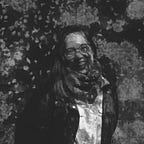Field Notes: Women on the field
I took this photo on the first Sunday of March. I was walking on the fields watching the people harvest rice. The sun was up but it was breezy enough to combat the heat. I saw Ate Cecil and her sister harvesting on the side.
“Ma’am ayaw anhi kay katol.” (Ma’am don’t come close. It’s itchy.)
So I stood far enough so I don’t get in their way but close enough so we can hear each other. If you stood beside me that day and looked around, you would see that there were only three women on the field as opposed to the fifteen (more or less) men on the field. Usually, there would be more men or young boys during harvest time.
Ate Cecil:“Ma’am wala ka gi-initan? Basin ma daot imong panit.” (Ma’am are you not hot? Your skin might get damaged.”
Me:“Ok ra ko te. Kamo? Wala mo initi?” (I’m fine. You? Are you not hot?)
Ate Cecil: “Mao naman gyud ni among panginabuhi ,Ma’am. Anad nami ani.” (This is our livelihood, Ma’am. We’re used to this.)
After our nice chat and as the heat grew intense, I went to the little shack for some shade. I watched them, especially the women, work the field under the scorching sun. With every seven sacks of grain harvested, six of it goes to the owner of the land and the one sack gets divided among those that worked the field and that’s their payment for the harvest. So the more they are able to harvest, the more grains they can take home to their families. Snacks or lunch or even water may or may not be provided by the land owner depending on the agreement. I have always heard about the injustice done to farmers; how the gain usually goes to the middlemen as they try to buy the grain at a bargain and sell the rice at a way higher price; how ironic it is that the farmer planted the rice and they can’t even afford the rice in the market. But it all hit home when the farmer is not just the ones I see in my book covers or from a story that I heard but an actual person I know and consider as family. I can write about all the stories of injustice on the field but it’s a story I will reserve for another day.
I knew nothing about this before moving here for our family’s business. Prior to this, I have lived all my life in the city. There were perceptions that were fed to my subconscious growing up. Perceptions on how a woman should carry herself, what roles she should be taking, and how she should present herself. As a Filipina, I grew up in an environment that puts pressure on us not to get “too dark”; a society that infer your economic status based on your skin color and thus treating you accordingly. I was conditioned to think that when I grow up, I should opt for jobs that do not require me to be on the field under the heat. It could be a contributing factor to why statistics show that there are more men than women involved in farming in our country. And as a woman, I was made convinced that a woman should become a mother at some point and devote her time in homemaking as that is our role. This image was shattered after looking at the women on the field.
These two are mothers; in fact the women on the field that day were all mothers working on a Sunday. Two of them had their husbands work with them side by side that day and the other had her husband look after their home. These are women working under the scorching sun, not really minding the heat. These are Filipinas working on the field, not really minding if they get “too dark”. And I stood there, as a single Filipina , looking at these mothers with so much awe. In fact, they were given the same amount of respect and paid the same amount of grains as their male counterparts. No one treated the other as lesser because of their skin color or gender.
I know this is just one of the many stories of the women on the field, a snippet of what Filipinas are becoming out there, a part of the picture of what women can be. And I wish to tell more stories to show what we can be; to change narratives that limit us and limit the future women.
